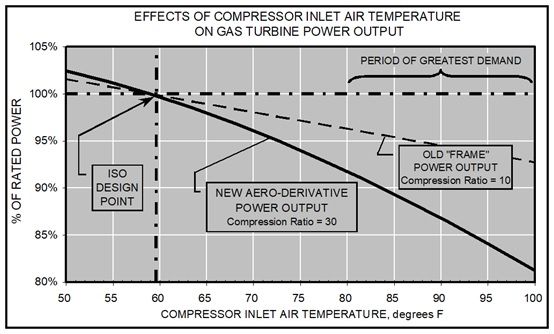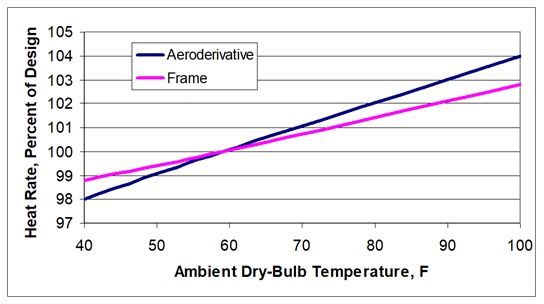How turbine inlet cooling can sync with changing load profiles of gas turbines
Gas turbine (GT) systems are well known worldwide for being a very efficient option for generating electric power on large scales. Modern GTs operating in combined-cycle mode achieve electric power generation efficiency as high as 61 percent.
While some of the GT systems support the base load demand, other GTs are brought online as requested by the regional transmission organization (RTO) in the U.S. to meet short term peak demands. Capacity payments to a power producer are based on the plant’s MW capacity and the energy payments are based on the electric energy it produces. A power producer is paid regularly for its capacity to commitment even if it is not called upon by the RTO for supplying electric energy. Since the installed capacity of renewable sources of electric power, such as solar and wind, has significantly increased, it has reduced the run hours of many GT systems. In addition, the intermittent nature of those renewable resources has created a need for a rapid response by GTs or other power systems, and has also increased the annual number of times a GT unit as to be started and shutdown.
This article discusses turbine inlet cooling (TIC) technologies and their importance for improving the performance and economics of GT-based electric power plants, as well as their relevance to the need for fast response time.
Air density impacts the performance of all gas turbines. Air density changes with changes in air temperature, humidity, and atmospheric pressure. Therefore, all GTs are rated at a standard set of ambient conditions. International Standards Organization (ISO)’s standard 3977-2 is used for rating GTs. It defines standard ambient conditions as 59oF, 60% relative humidity, and atmospheric pressure at sea level.An increase in ambient temperature has the most impact on decreasing the air density and performance of GTs. Increase in ambient temperature also increases demand for electric power due to increased use of air conditioning equipment in buildings. Increased demand for electric power results in increased market price of electric energy.
Unfortunately, increase in ambient temperature reduces the output capacity and the efficiency of GT systems, just when electric power demand and electric energy prices are high. The extent of the impact of increased temperature varies with the GT design. Some examples of the effect of ambient temperature on the output capacity and heat rate of GTs are shown in Figures 1 and 2, respectively. Increase in ambient temperature not only reduces the electric output of the gas turbine, it also reduces the mass flow rate of its exhaust gas, though with a slight increase in the temperature of the exhaust gas. On an overall basis, the total thermal energy of the exhaust gas decreases with increase in ambient temperature. Since a combined-cycle system uses the GT exhaust gas to generate steam for operating a steam turbine, an increase in ambient temperature also reduces the output of the steam

Figure 1: Effect of Ambient Air Temperature on Power Output of Gas Turbines[/caption]

Figure 2: Effect of Ambient Air Temperature on Heat Rate of Gas Turbines[/caption]
turbine. Similarly, an increase in ambient temperature also reduces the capacity of heating and cooling equipment in other modes of GT operation, such as cogeneration or combined heat and power (CHP).
Since the increase in ambient temperature reduces the performance of GTs, it follows that cooling the inlet combustion air prevents the detrimental impact by increasing their capacity and efficiency. Fortunately, a number of commercially-proven turbine inlet cooling (TIC) technologies have been successfully implemented. The time to reach steady state from cold start for five of these technologies, shown in Table 1, ranges from 2 to 15 minutes, depending on the total system capacity, ambient temperature and the desired cooled air temperature.
TIC Technology
Time to Reach Steady State from Cold Start, Minutes
Wetted-Media
6
Fogging
3-2
Wet Compression
10
Chilled Water
15-10
Thermal Energy Storage
<10
These startup times for TIC technologies are comparable to the startup time of 10 minutes, from cold start, for the newer simple-cycle GT systems. The startup times of all combined-cycle systems and older simple-cycle systems are much longer than 10 minutes. Therefore, TIC systems do not impede the startup times of GT-based power plants in response to system demand swings brought about by the renewable power generation systems.
No one TIC technology is best for all applications. Each technology has its pros and cons. Selection of the most economically-attractive TIC technology depends on many factors including, value of the additional electric energy produced, weather data for the plant location, number of hours TIC will be operated per year, GT design, and fuel cost. A good resource for information on all TIC technologies is the website (www.turbineinletcooling.org) of the Turbine Inlet Cooling Association (TICA), which is a non-profit trade association that promotes the development and exchange of knowledge related to TIC. The TICA website is the one-stop source of information about all TIC technologies, including a database over 400 installations.
Market price of electricity is high when the demand for power is high. Power demand is high when ambient temperature is high because of increased air conditioning load. Since TIC cooling mitigates the loss of GT output capacity when the ambient temperature is high, it allows power producers to bid for higher capacity than would be possible without TIC. Since TIC also increases electric generation efficiency, it allows power producers to produce electricity at lower fuel cost than that possible without TIC.
Since GT combined-cycle systems are more efficient than simple-cycle GT systems, TIC applied to combined-cycle systems reduces the need to operate simple-cycle systems for meeting the market demand. Similarly, TIC applied to simple-cycle systems, reduces the need to operate still lower efficiency systems. Therefore, TIC not only helps increase GT output capacity and efficiency, it also helps reduce emissions for electric power generation.